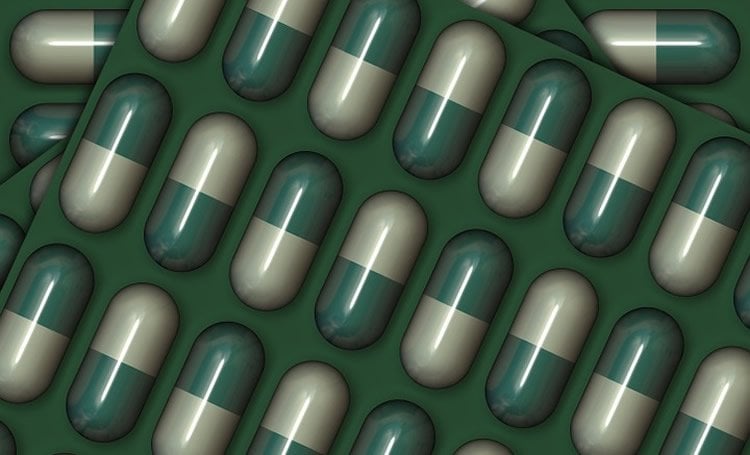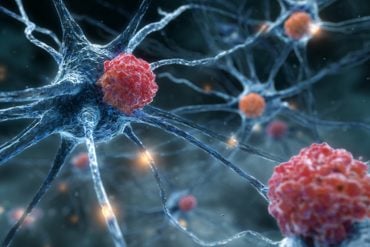Summary: Researchers have mapped out a serotonin-driven anxiety circuit that may explain the side effects of anxiety and fear experienced by some patients taking SSRIs.
Source: University of North Carolina.
UNC School of Medicine researchers map the anxiety circuit in the brain and use a compound to limit fearful behavior – an acute side effect of commonly prescribed SSRI antidepressants.
More than 100 million people worldwide take selective serotonin reuptake inhibitors (SSRIs), such as Prozac and Zoloft, to treat depression, anxiety and related conditions, but these drugs have a common and mysterious side effect: they can worsen anxiety in the first few weeks of use, which leads many patients to stop treatment. Scientists at the University of North Carolina (UNC) School of Medicine have mapped out a serotonin-driven anxiety circuit that may explain this side effect and lead to treatments to eliminate it.
“The hope is that we’ll be able to identify a drug that inhibits this circuit and that people could take for just the first few weeks of SSRI use to get over that hump,” said senior investigator Thomas L. Kash, PhD, the John Andrews Distinguished Professor of Alcohol Studies in the UNC School of Medicine’s department of pharmacology. “More generally, this finding gives us a deeper understanding of the brain networks that drive anxiety and fear behavior in mammals.”
The new study, published in Nature, counters the popular view of serotonin as a neurotransmitter that promotes only good feelings. SSRIs, which are taken by about one in 10 people in the United States and about one in four women in their 40s and 50s, are thought to improve mood by boosting serotonin activity in the brain. There are brain circuits through which serotonin does seem to improve mood, and some studies have linked depression to abnormally low levels of serotonin. But the short-lived promotion of anxiety in many patients on SSRIs – even suicidal thinking, particularly in younger people – has long hinted that serotonin can have negative effects on mood, depending on the precise brain circuit where it acts.
In the Nature study, for which co-authors were UNC postdoctoral researcher Catherine A. Marcinkiewcz, PhD, and UNC graduate student Christopher M. Mazzone, the researchers used an array of sophisticated methods, including advanced optogenetic and chemogenetic tools, to trace a serotonin-activated pathway in the brains of mice, a pathway that drives anxious behavior.
The team first demonstrated that a mild shock to the paws of mice – a standard method for evoking fear and anxiety behaviors – activates serotonin-producing neurons in the dorsal raphe nucleus (DRN), a brainstem region known to be involved in mood and depression. These DRN serotonin neurons project to a brain region that is called the bed nucleus of the stria terminalis (BNST) and has been shown in previous studies to have a role in serotonin’s negative mood effects in rodents. Artificially increasing the activity of the DRN-to-BNST neurons enhanced anxiety-like behaviors in the mice.
UNC scientists found that the serotonin output from the DRN neurons activates their target neurons in the BNST through a specific subset of serotonin receptors, known as 2C receptors. These serotonin-activated BNST neurons then tamp down the activity of another family of BNST neurons, which, in turn, project to the ventral tegmental area (VTA) and lateral hypothalamus (LH) – key nodes in the brain’s reward, motivation and alertness networks.
The pathways from BNST to VTA and LH have been reported in previous studies to improve mood and relieve anxiety. Researchers confirmed that artificially driving the activity of these pathways has the effect of reducing foot-shock-induced fear and anxiety behaviors in the mice. By contrast, the silencing of these pathways by serotonin-activated BNST neurons effectively allows the anxiety level to rise.
Examining the impact of SSRIs, the scientists exposed 2C-receptor BNST neurons to fluoxetine (Prozac), which like other SSRIs gives a boost to serotonin levels wherever the neurotransmitter is at work. This turned out to increase the 2C-receptor neurons’ inhibitory effect on the neighboring VTA- and LH-projecting neurons, worsening fear and anxiety behavior in mice.
How can this effect be blocked? Kash and his team observed that the anxiety-mediating BNST neurons expressed the stress-signaling molecule corticotropin releasing factor (CRF). When they added a compound to block CRF activity, they witnessed that fearful behaviors – which had been triggered by fluoxetine – were greatly reduced.
One of the next steps is to confirm that this serotonin-sensitive DRN-to-BNST anxiety circuit exists in humans as well. “It’s logical that it would,” Kash said, “since we know SSRIs can induce anxiety in people, and the pathways in these brain regions tend to be very similar in mice and humans.”

Another next step will be to test drugs – ideally FDA-approved for various conditions – for their ability to alter this anxiety circuit and thereby block SSRIs’ anxiety-inducing effect. In principle, a CRF-blocker might work. For years, pharmaceutical companies have been trying to develop CRF blockers to treat depression, anxiety and addiction. In practice, Kash said, CRF blockers haven’t yet had success in clinical trials, so an FDA-approved one is probably still years away at least.
“Other researchers are working to develop better CRF-inhibiting compounds, so that’s one potential direction to take, but there are others,” Kash said. “We’re now looking at the various proteins expressed by these BNST neurons, and we’re hoping to identify a receptor that is already targeted by established drugs. One of them might be useful for people as they start taking SSRIs.”
Other authors of the study were Giuseppe D’Agostino, PhD, research fellow at the University of Aberdeen; Lindsay R. Halladay, PhD, research fellow at the National Institutes of Health; J. Andrew Hardaway, postdoctoral fellow in the Kash Lab; Jeffrey F. DiBerto, research technician in the Kash Lab; Todd E. Thiele, PhD, professor of psychology at UNC; Montserrat Navarro, PhD, associate research professor of psychology and neuroscience at UNC; Nathan Burnham, graduate student in the Thiele Lab; Lora K. Heisler, PhD, chair of human nutrition at the University of Aberdeen; Claudia Cristiano, PhD, research fellow in the Heisler Lab; Cayce E. Dorrier, undergraduate research assistant in the Kash Lab; Gregory J. Tipton, research specialist at the UNC Center for Alcohol Studies; Charu Ramakrishnan, lab manager for Deisseroth Lab; Tamas Kozicz, MD, PhD, associate professor of anatomy at Tulane University; Karl Deisseroth, MD, PhD, professor of bioengineering, and psychiatry and behavioral sciences at Stanford University; Zoe A. McElligott, PhD, assistant professor of psychiatry at UNC; and Andrew Holmes, PhD, senior investigator at the National Institute on Alcohol Abuse and Alcoholism.
Source: University of North Carolina
Image Source: This NeuroscienceNews.com image is in the public domain.
Original Research: Abstract for “Serotonin engages an anxiety and fear-promoting circuit in the extended amygdala” by Catherine A. Marcinkiewcz, Christopher M. Mazzone, Giuseppe D’Agostino, Lindsay R. Halladay, J. Andrew Hardaway, Jeffrey F. DiBerto, Montserrat Navarro, Nathan Burnham, Claudia Cristiano, Cayce E. Dorrier, Gregory J. Tipton, Charu Ramakrishnan, Tamas Kozicz, Karl Deisseroth, Todd E. Thiele, Zoe A. McElligott, Andrew Holmes, Lora K. Heisler & Thomas L. Kash in Nature. Published online August 24 2016 doi:10.1038/nature19318
[cbtabs][cbtab title=”MLA”]University of North Carolina. “How Do Antidepressants Trigger Fear and Anxiety?.” NeuroscienceNews. NeuroscienceNews, 24 August 2016.
<https://neurosciencenews.com/anxiety-fear-antidepressants-4905/>.[/cbtab][cbtab title=”APA”]University of North Carolina. (2016, August 24). How Do Antidepressants Trigger Fear and Anxiety?. NeuroscienceNews. Retrieved August 24, 2016 from https://neurosciencenews.com/anxiety-fear-antidepressants-4905/[/cbtab][cbtab title=”Chicago”]University of North Carolina. “How Do Antidepressants Trigger Fear and Anxiety?.” https://neurosciencenews.com/anxiety-fear-antidepressants-4905/ (accessed August 24, 2016).[/cbtab][/cbtabs]
Abstract
Serotonin engages an anxiety and fear-promoting circuit in the extended amygdala
Serotonin (also known as 5-hydroxytryptamine (5-HT)) is a neurotransmitter that has an essential role in the regulation of emotion. However, the precise circuits have not yet been defined through which aversive states are orchestrated by 5-HT. Here we show that 5-HT from the dorsal raphe nucleus (5-HTDRN) enhances fear and anxiety and activates a subpopulation of corticotropin-releasing factor (CRF) neurons in the bed nucleus of the stria terminalis (CRFBNST) in mice. Specifically, 5-HTDRN projections to the BNST, via actions at 5-HT2C receptors (5-HT2CRs), engage a CRFBNST inhibitory microcircuit that silences anxiolytic BNST outputs to the ventral tegmental area and lateral hypothalamus. Furthermore, we demonstrate that this CRFBNST inhibitory circuit underlies aversive behaviour following acute exposure to selective serotonin reuptake inhibitors (SSRIs). This early aversive effect is mediated via the corticotrophin-releasing factor type 1 receptor (CRF1R, also known as CRHR1), given that CRF1R antagonism is sufficient to prevent acute SSRI-induced enhancements in aversive learning. These results reveal an essential 5-HTDRN→CRFBNST circuit governing fear and anxiety, and provide a potential mechanistic explanation for the clinical observation of early adverse events to SSRI treatment in some patients with anxiety disorders
“Serotonin engages an anxiety and fear-promoting circuit in the extended amygdala” by Catherine A. Marcinkiewcz, Christopher M. Mazzone, Giuseppe D’Agostino, Lindsay R. Halladay, J. Andrew Hardaway, Jeffrey F. DiBerto, Montserrat Navarro, Nathan Burnham, Claudia Cristiano, Cayce E. Dorrier, Gregory J. Tipton, Charu Ramakrishnan, Tamas Kozicz, Karl Deisseroth, Todd E. Thiele, Zoe A. McElligott, Andrew Holmes, Lora K. Heisler & Thomas L. Kash in Nature. Published online August 24 2016 doi:10.1038/nature19318







